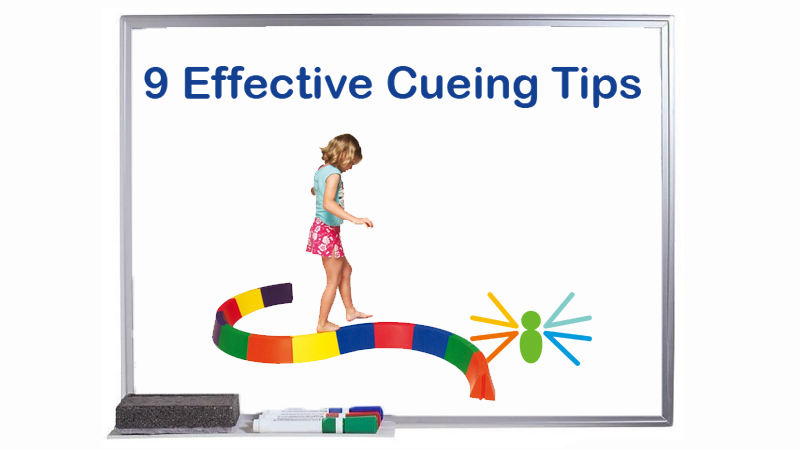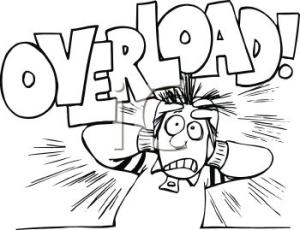Craig Valency, MA, CSCS
“Don’t round your back!”
“Chest up, butt out, head up!”
“Stay low, and stop bobbing your head up and down!”
If you’ve been on the receiving end of this barrage of commands, I can guarantee you that frustration, rather than improved movement skills, was usually the outcome.
Once a movement skill has been taught, feedback is important. A simple cue can have a dramatic impact on perfecting a movement, but it can also do damage by making someone feel like a failure. Worse yet, if given incorrectly or overused, cues can take all the fun out of learning and create an environment that does not encourage an intrinsic desire to be more active.
After close to twelve years of working with kids from five to eighty-five years of age, I’ve made all the mistakes. My cues made sense to me! I could not understand why my clients and students were often unable to make the simple adjustments.
Once my ego was successfully wrestled to the ground, I realized it had to be me, not them. I’m the movement expert. Of course I get it! I had to put myself in the head of someone who was new to these movements, and figure out the best way to convey a verbal picture with just a few words to create that “Aha” moment.
Here are my top 9 cueing tips, pitfalls, & successes:
- The master CUE – Find the one cue that will create a cascade effect and lead to improvement throughout the rest of the body. Typically wherever the eyes go, so goes the head, shoulders, back and rest of the body. One cue such as “Look straight ahead” can go a long way to replace, “Head up,” “Chest up,” and “Don’t round your back.”
 CUE overload – If you see smoke coming out of a child’s ears, you may have caused a short circuit as a result of cue overload! Allow children to make mistakes and explore movement before they are hit with a cue storm. This will help them get out of their head and begin to develop body wisdom. Let them figure out solutions through exploration, and they may even come up with an effective technique that is better than what you intended! It is also important to let kids feel their mistakes so they have a contrast to the proper movement. Once they have explored options and learned from their experience, one or two cues is enough to start with to get them on the right track. And this conveniently leads us to …
CUE overload – If you see smoke coming out of a child’s ears, you may have caused a short circuit as a result of cue overload! Allow children to make mistakes and explore movement before they are hit with a cue storm. This will help them get out of their head and begin to develop body wisdom. Let them figure out solutions through exploration, and they may even come up with an effective technique that is better than what you intended! It is also important to let kids feel their mistakes so they have a contrast to the proper movement. Once they have explored options and learned from their experience, one or two cues is enough to start with to get them on the right track. And this conveniently leads us to …
- Changing the world one CUE at a time – In this method you deliberately choose just one cue to emphasize for a complex skill such as a squat. Resist the temptation to correct any other mistakes. When the kids are working on squat technique, you, of course, don’t want to see a rounded back or heels coming off the ground. But just start with one cue and ignore other mistakes. The children hear a simple, consistent, cue that is easy to recall and apply and you, the teacher, coach, or trainer, can circulate throughout the entire class more quickly as they only have to focus on one aspect of the skill.
- A CUE draught – This is basically just watching kids play. If it’s recess time, great! But if it’s time to teach physical literacy, there needs to be a purpose behind everything that is said or not said. I’m sure we’ve all caught ourselves saying, “That’s probably the best Billy can do. It’s pretty close. He’s just not going to get it now.” Don’t give up on any child! We may have to adjust the task or objective, but with proper cueing most kids will be able to approximate proper form. If left unchecked for too long, kids end up grooving incorrect movement patterns. Once engrained, those patterns cannot be unlearned! At that point, they must then create additional new, neural pathways in order to learn new movements.
- Positively negative CUES – Choose the positive route and tell kids what you want to see, not what you don’t want to see. Words are incredibly powerful. While their ears may hear the “Don’t,” their body is hearing everything else. Why mention exactly what you don’t want to happen, and reinforce an error? Paint a verbal picture of what should happen. “Chest up” is better than “Don’t round your back!”
- Abstract CUES – Don’t confuse kids. It’s good to be specific about what you want to see using the terms they understand. However, there is a time and place for the abstract “ethereal” cue. This cue is done to help kids explore movement options that might work best for them by evoking a feeling, emotion, or image. For example for the lateral slide/ shuffle: “Imagine you are gliding on ice.” For pogo hops: “You’ve got springs on the bottom of your shoes,” or if your feeling super creative: “You are light as air.” For a single leg balance reach, tell them that they are surrounded by water and you just want them to see if the water is cold, without falling in! If they put any weight on that leg, they will know it! It they are doing a prone back extension (Superman) please don’t say, “Retract your scapula,” or even “Pull your shoulder blades together.” Instead, tell them, “Imagine that you’re pinching a pencil between your shoulder blades.”
- Projection CUES – After you’ve given the standard cues, the movement may still be subpar. By simply projecting what you want to see you will be amazed at how it can become a reality. Kids, and even adults, yearn to please us and live up to our expectations of them. So if they aren’t quite doing it, just tell a little white lie and say, “I like how you are…” and fill in the blank. You will be amazed at how quickly the correct movement takes over. For instance instead of saying, “Chest up!” say, “I like how you are keeping your chest up on that squat, Cindy!” or instead of “Keep your head level on that lateral slide,” say: “I like how you’re keeping your head level on that lateral slide,” even they aren’t doing those things just right! And for good measure, throw in an abstract projection cue: “It looks like you’re gliding on ice!” I’ve had the best results, by far, using projection cues.
- Self-CUEING – Give just one mantra that you want the child to say that will reinforce a key point or rhythmic quality during the movement. For agility ladder drills it could be, “In, in, out, out,” or just chanting or clapping a rhythmic pattern. For the overhand throw it could be “Follow-through, follow through…” This strategy will shift some of the responsibility back to the child and gives them more buy-in for their own success.
- Visual CUES – Just using hand or body gestures can do wonders to get an idea across. Simply gliding your hand across the horizon could be a great cue to keep the head level. Modeling the specific move yourself or through peer coaching is an ideal way to create a big picture and reduce some of the overthinking that goes into a complex movement pattern. Mirror neurons fire and aid in the replication of perfect movement with technique as well. You can also combine this with a verbal cue – just one or two will do.
Teaching a skill is only half the battle. The feedback you give in the form of cues can make or break a child’s ability to learn new movement properly and your ability to best manage your sessions.
The key to good cueing is to make it simple and age appropriate. Provide cues at the right time, and allow kids to feel their mistakes and explore movement. Keep it positive, and even praise things that you want them to do even if they aren’t quite there yet. Tap into their senses and use audio, visual, and tactile cues to appeal to all kinds of learners.
Try out these 9 cueing tips to give you the edge in helping kids learn movement and enjoy the process. If you have any other cueing or feedback strategies that have worked for you, we’d love to hear them!
Craig Valency, MA, CSCS, president and co-founder of SPIDERfit, has been a personal trainer for the last 11 years. He is currently working at Fitness Quest 10 in San Diego, an elite personal training and athletic conditioning facility. He specializes in youth strength and conditioning programs that promote physical literacy, injury prevention and optimal performance. Along with training youths from 6 to 18 years of age for general fitness, Craig has also worked with some of the top junior tennis players in the world. He has been a physical education consultant for the Stevens Point school district in Wisconsin for the last 3 years, helping revamp the district wide programming for the K-12 PE curriculum. Craig earned his bachelor degree from UCLA, and Masters Degree in Kinesiology from San Diego State University.






Great article. I would add: never give more than 3 cues at a time. I usually stick to one. Although I think that was covered.
Thanks for the comment Sean! I agree that for me as well the biggest take away is to have a clear, concise cue that will help improve or refine a movement without adding confusion.
If you have to start using 3 or more cues the skill was probably not taught well enough in the first place with the proper progressions and feedback.
It’s tough for all of us to avoid the temptation to correct every mistake we see, but in this case less is truly more! There will be plenty of time to perfect the movement, but if there is “cue overload” nothing will get in!
I look forward to reading more of your comments. Thanks Sean!
I love the one about giving positive cues! Such an important reminder. Great article 💚
Thanks Ashley! Keep inspiring!